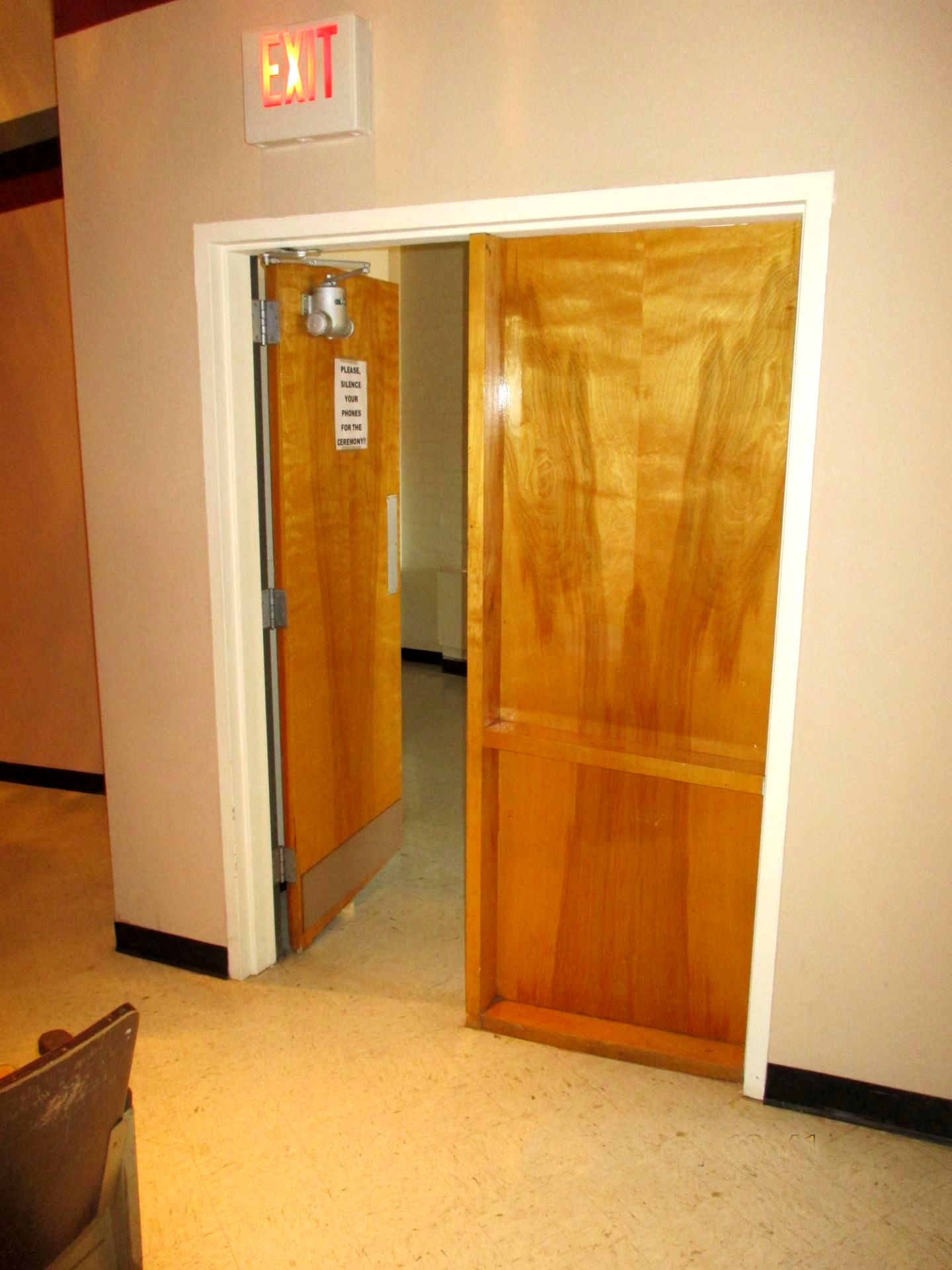I can’t believe I first wrote this article 10 years ago! An AHJ recently asked me about calculating the egress width of a door, so I’ve updated this article with current code references.
This Decoded article was published in Door Security + Safety
.


This pair of doors has been changed to a single door with a fixed panel. The AHJ must be consulted before a modification like this is begun.
A common question when replacing doors and hardware during a renovation is whether one leaf of a pair can be “fixed” in place, or whether an opening can be eliminated completely. It’s very risky to make this decision without consulting the Authority Having Jurisdiction (AHJ), but it is helpful to understand some of the factors that could affect the location, size, and quantity of required exits before preparing your request for the AHJ.
Generally, the International Building Code (IBC) requires each space to have at least two exits or exit access doorways, and Chapter 10 states, “It shall be unlawful to alter a building or structure in a manner that will reduce the number of exits or the capacity of the means of egress to less than required by this code.” But the required number of exits / exit access doorways may be increased or decreased depending on several factors:
- For rooms or spaces with a low occupant load, one exit may be acceptable. For example, Table 1006.2.1 in the 2024 edition of the IBC allows a single exit for assembly, business, educational, factory and industrial, mercantile, and utility occupancies with an occupant load of 49 or less, if the common path of travel is within a certain length.
- For larger spaces in these use groups with an occupant load of more than 49, a second exit would be required.
- For spaces with a high occupant load, the IBC requires additional exits – a minimum of 3 exits for any space with an occupant load of 501 to 1,000, and 4 exits if the occupant load is more than 1,000.
- Consult the code for information specific to your project, as there are several exceptions to these requirements.
In recent editions of the IBC, Section 1005 covers Means of Egress Sizing, including sizing for stairways and “other egress components” – doors, gates, corridors, aisles, and ramps. The required egress width for these “other” components of an egress route is calculated by multiplying the occupant load served, by the egress capacity factor (note that stairways have a different egress capacity factor):
- For buildings without a sprinkler system and emergency voice/alarm communication system – the egress capacity factor is 0.2 inches per occupant.
- For H (high hazard) and I-2 (institutional – typically hospitals and nursing homes; refer to the code for the full definition) – the egress capacity factor for doors is 0.2 inches per occupant.
- For other use groups (H and I-2 excluded) with a sprinkler system and emergency voice/alarm communication system – the egress capacity factor for doors is 0.15 inches per occupant.
For example, if the occupant load of a nonsprinklered space is 300 occupants, the required egress width of the exits or exit access doorways serving that space is 300 occupants x 0.2 inches per occupant = 60 inches. So the egress doors serving that space must have a total of 60 inches of clear width. This doesn’t mean that an equal pair of doors providing 30 inches of clear width each is sufficient, because of the requirements for multiple exit locations and minimum clear width (read on).
 To determine the egress capacity of a door, or how many people a door will accommodate, divide the clear opening width of the door by 0.2 inches per occupant or 0.15 inches per occupant (see above to choose which factor to use). For example, if a door in a nonsprinklered building has a clear opening width of 32 inches, the egress capacity of that door would be 32 inches / 0.2 inches per occupant = 160 occupants.
To determine the egress capacity of a door, or how many people a door will accommodate, divide the clear opening width of the door by 0.2 inches per occupant or 0.15 inches per occupant (see above to choose which factor to use). For example, if a door in a nonsprinklered building has a clear opening width of 32 inches, the egress capacity of that door would be 32 inches / 0.2 inches per occupant = 160 occupants.
The clear opening width of a door is measured from the face of the door with the door open 90 degrees, to the stop on the strike jamb of the frame. For pairs of doors, the clear width of the active leaf is measured from the face of the door to the removable mullion or to the edge of the inactive leaf in the closed position. To calculate the egress width of the entire opening for a pair without a mullion, measure between the faces of both doors when open to 90 degrees.
If you’re looking at a door on a set of plans rather than measuring the clear width of an existing door, the exact clear opening width can vary slightly depending on the hinges or pivots. But a rule of thumb to find the nominal clear opening width for a single door hung on full mortise hinges is to take the frame opening width and subtract half of the hinge width, the hinge backset, and the height of the stop on the strike jamb. So for a 3-foot door that is hung on 4 1/2-inch-wide hinges with a ¼-inch hinge backset and a 5/8-inch stop, the calculation would be 36 inches (frame opening width) – (2 ¼ inches (half of the hinge width) + ¼ inch (hinge backset) + 5/8 inch (frame stop)) for a total of 32 7/8 inches of clear width.
Remember, doors in a path of egress and doors on an accessible route are typically required to have a clear opening width of at least 32 inches. In some cases this required width is increased for doors in health care facilities, or may be decreased for some existing doors. For pairs of doors, at least one leaf is required to provide the 32-inch clear width unless the applicable code or standard contains an exception that would allow an alternative.
There are additional factors that may affect the size and location of egress doors, such as limitations on travel distance and the common path of travel, as well as the requirement for exits to be remotely located from each other. These requirements will be covered in the next edition of Decoded.
Photo: Logan Piburn, Dyron Murphy Architects.
You need to login or register to bookmark/favorite this content.










Very good
Also watch maximum door width
Good point! I will add the maximum width – thanks Charles!
“For example, if the occupant load of a nonsprinklered space is 300 occupants, the required egress width of the exits or exit access doorways serving that space is 300 occupants x 0.2 inches per occupant = 60 inches. So the egress doors serving that space must have a total of 60 inches of clear width. This doesn’t mean that a pair of 30-inch wide doors is sufficient, because of the requirements for multiple exit locations and minimum clear width (read on).”
I’m a little confused. Does a 30-inch wide pair of doors have a clear width of 60 inches? Seems like it would be 58 3/4″ with swing clear hinges and 5/8″ stops on frame. Or, am I not understanding correctly?
P.S. – I’m really learning a lot on your “Decoded” webinar.
Thanks.
on the building code, Is the multiplier 0.2 for number occupants for a 36″ door or for the net width of a 36″ door which is 33″? Thanks
Hi Edwin –
You use the clear width measured from the face of the door (open to 90 degrees) to the stop on the strike jamb. For most 3-foot doors the clear width is around 33 inches.
– Lori
Where would i find in IBC the req’d min width of a door into an interior exit stair in an I-2 occupancy? Is it 32” or 41.5” (presuming occupant load is not dictating)
Hi Ed –
The 41 1/2-inch width applies where the doors have to accommodate the movement of beds. The stair doors probably don’t have to accommodate beds so they would normally have a minimum clear width of 32 inches. Here’s where it is in the 2018 IBC:
1010.1.1 Size of doors. The required capacity of each door opening shall be sufficient for the occupant load thereof and shall provide a minimum clear opening width of 32 inches (813 mm). The clear opening width of doorways with swinging doors shall be measured between the
face of the door and the stop, with the door open 90 degrees (1.57 rad). Where this section requires a minimum clear opening width of 32 inches (813 mm) and a door opening includes two door leaves without a mullion, one leaf shall provide a minimum clear opening width of 32
inches (813 mm). In Group I-2, doors serving as means of egress doors where used for the movement of beds shall provide a minimum clear opening width of 41 1/2 inches (1054 mm). The maximum width of a swinging door leaf shall be 48 inches (1219 mm) nominal. The minimum
clear opening height of doors shall be not less than 80 inches (2032 mm).
There are some exceptions that follow this section.
– Lori
helpful
So, if a space has an occupant load of 49 with one exit, can that number be 63 if the one exit is a rollup door? The space is an art studio/gallery and the only time they have people is when there is a showing and they use the rollup door as their entrance and exit. I told them it has to be 49 but previously they were told be someone else 63… Thanks.
I’ve never heard of a door-related requirement that is specifically for an occupant load of 63. With an occupant load over 49, the gallery would require a second exit – here’s more info on that: https://idighardware.com/2020/10/qq-number-of-exits/.
The IBC requires egress doors to be side-hinged swinging doors, with some exceptions. I don’t see an exception here that would specifically allow a roll-up door in the means of egress from the type of space you described:
1010.1.2 Egress door types. Egress doors shall be of the side-hinged swinging door, pivoted door, or balanced door types.
Exceptions:
1. Private garages, office areas, factory and storage areas with an occupant load of 10 or less.
2. Group I-3 occupancies used as a place of detention.
3. Critical or intensive care patient rooms within suites of health care facilities.
4. Doors within or serving a single dwelling unit in Groups R-2 and R-3.
5. In other than Group H occupancies, revolving doors complying with Section 1010.3.1.
6. In other than Group H occupancies, special purpose horizontal sliding, accordion or folding door assemblies complying with Section 1010.3.3.
7. Power-operated doors in accordance with Section 1010.3.2.
8. Doors serving a bathroom within an individual sleeping unit in Group R-1.
9. In other than Group H occupancies, manually operated horizontal sliding doors are permitted in a means of egress from spaces with an occupant load of 10 or less.
It’s possible that an AHJ might allow the rollup door based on this paragraph, if the gallery is a business occupancy:
1010.3.4 Security grilles. In Groups B, F, M and S, horizontal sliding or vertical security grilles are permitted at the main exit and shall be openable from the inside with-out the use of a key or special knowledge or effort during periods that the space is occupied. The grilles shall remain secured in the full-open position during the period
of occupancy by the general public. Where two or more exits or access to exits are required, not more than one-half of the exits or exit access doorways shall be equipped
with horizontal sliding or vertical security grilles.
I hope this helps.
– Lori
Does the second door need to be in back? Or the front near the original door? Or does it not even matter? I’m looking at a 1700 sq ft retail on the second floor and it has 1 door. I need a capacity of at least 150 f0r me to lease the space for a bar.
Hi Rick –
I think this post answers your question about where the doors need to be located:
https://idighardware.com/2021/02/qq-remoteness-of-exit-access-doorways/.
– Lori
When calculating the occupant load on exit doors for a story, does the maximum allowable travel distance become a factor? I’m working on a school project and, for example, a particular classroom has three exits that are withing the maxiumum allowable travel distance. Do I divide that classroom’s occupant load equally between those three doors and disregard other exits on that story that are not within the maximum allowable travel distance? The firm I work for currently takes the entire story’s occupant load and divides it equally across all exits. Which is correct? Thanks in advance.
I’ve since found an NFPA article that states “Although more than one exit might be required, the travel distance to exits other than the closest exit is not regulated.” This leads me to believe that dividing an entire story’s occupant load equally among all exit doors is the proper method.